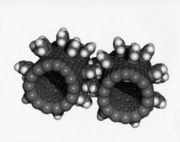
Nanotechnology is a field of applied science focused on the design, synthesis, characterization and application of materials and devices on the nanoscale. Nanotechnology is a subclassification of technology in colloidal science, biology, physics, chemistry and other scientific fields and involves the study of phenomena and manipulation of material at the nanoscale, in essence an extension of existing sciences into the nanoscale. Two main approaches are used in nanotechnology: one is a "bottom-up" approach where materials and devices are built up atom by atom, the other a "top-down" approach where they are synthesized or constructed by removing existing material from larger entities. A unique aspect of nanotechnology is the vastly increased ratio of surface area to volume present in many nanoscale materials, which opens new possibilities in surface-based science, such as catalysis. This catalytic activity also opens potential risks in their interaction with biomaterials The impetus for nanotechnology has stemmed from a renewed interest in colloidal science, coupled with a new generation of analytical tools such as the atomic force microscope (AFM) and the scanning tunneling microscope (STM). Combined with refined processes such as electron beam lithography, these instruments allow the deliberate manipulation of nanostructures. These new materials and structures have in turn led to the observation of novel phenomena such as the “quantum size effect” where the electronic properties of solids are altered with great reductions in particle size. This effect does not come into play by going from macro to micro dimensions. However, it becomes dominant when the nanometer size range is reached. Nanotechnology is also used as an umbrella term to describe emerging or novel technological developments associated with microscopic dimensions. Despite the great promise of numerous nanotechnologies such as quantum dots and nanotubes, real applications that have moved out of the lab and into the marketplace have mainly utilized the advantages of colloidal nanoparticles, such as suntan lotion, cosmetics, protective coatings and stain resistant textiles.

